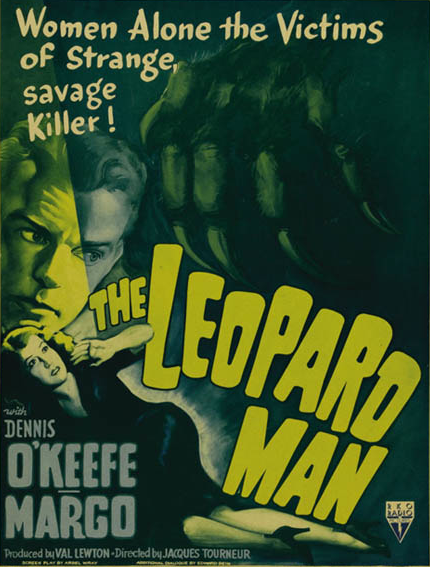The Leopard Man & Fate

Introduction
My response to Elliot Lavine’s analysis of The Leopard Man initiated a discussion on The Blackboard website that ran under the thread, “Is noir really fatalistic?” (To read my response, see the page The Leopard Man vs. Hardboiled.)
My post for the discussion is below.
For my challenge to the common tenet of the hardboiled paradigm that fate is a basic “noir element,” see the page Repeat Performance vs. Hardboiled.
Presentation
The following is spoken by Dr. Galbraith (The Leopard Man).
“I’ve learned one thing about life: we’re a good deal like that ball dancing on the fountain. We know as little about the forces that move us and move the world around us as that empty ball does…about the water that pushes it into the air and lets it fall and catches it again.”
Here is my question: Is the bouncing ball in The Leopard Man a symbol of fate or a hardboiled attitude toward other people?
The bouncing ball on the fountain in The Leopard Man has been associated with fate, in the sense that people can’t control their destinies.
I suggest that the better reading of this symbol, based on a full citation of the dialog in the film, is that it is associated with a cold, hardboiled attitude toward life, toward other people. This is the very attitude that is rejected in The Leopard Man, as shown by the conversations and experiences of the lead characters, Jerry and Kiki. (See the page The Leopard Man vs. Hardboiled.)
Jerry wants to talk to Galbraith about the leopard.
Galbraith: Are you worried about its killing someone else?
Jerry: Not me. I’m not worried about anything….
Galbraith: Why do you think you must seem hard and disinterested?….
Jerry: Where I was brought up you had to be tough. It was a tough neighborhood. I learned it didn’t pay to let anybody know how you feel or really think….
Galbraith explains that the leopard prefers to be in open country instead of where there are walls, streets and people.
Jerry realizes that this fact means that the leopard is unlikely to still be in the town and, therefore, it’s unlikely to harm much less kill people again. Jerry is very relieved by this.
Galbraith: Don’t feel so concerned, Jerry. I’ve learned one thing about life: we’re a good deal like that ball dancing on the fountain. We know as little about the forces that move us and move the world around us as that empty ball does…about the water that pushes it into the air and lets it fall and catches it again. You shouldn’t feel too bad about Theresa Delgado. [Theresa is a young girl in the town who is killed by an escaped leopard. For the plot summary of the film, see the page The Leopard Man vs. Hardboiled.]
Jerry is taken aback by Galbraith’s cold, hardboiled attitude toward the killing of young Theresa.
In other words, to Galbraith, the bouncing ball isn’t a symbol of how we don’t have control of what happens to us. It is a symbol that, because we don’t have control, we shouldn’t care what happens to others.
This attitude is explicitly rejected by Jerry and Kiki. Their rejection of the bouncing ball as a meaningful symbol of how life should be lived occurs in the final lines of the film, when Jerry says, “Kiki, Galbraith said something to me, something that you ought to know. We were talking and he said that people were like that ball in the fountain at the hotel. That they get pushed around by things bigger than themselves. That’s the way it was with us, only we were too small to see it that way.” Kiki smiles at Jerry. They walk away, arm in arm, and the film ends.
Notably, it is Galbraith who interprets the bouncing ball as a symbol that justifies not caring about what happens to others. Galbraith is unable to prevent himself from becoming like an animal and, therefore, he ceases to be fully human. Those who are fully human, and in control of choices they make about how they wish to live, like Jerry and Kiki, reject Galbraith’s interpretation of the bouncing ball.